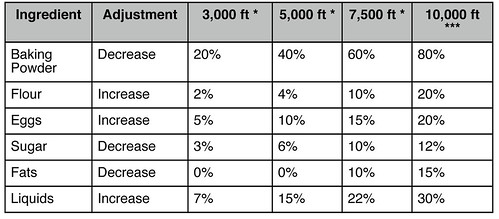This is a guest post from Porche Lovely, proprietress of Church of Cupcakes in Denver! Read her bio below.
The idyllic Rocky Mountains have inspired poets and songwriters from Katharine Lee Bates' “America the Beautiful” to John Denver's “Rocky Mountain High.” Icicles decorate the frosted roofs of mountain lodges and parkas and hiking boots are everyday fashion. Skiers and one-horse open sleighs float through drifts of snow as white and light as the fluffiest meringue. Alas the same altitude that draws outdoor enthusiasts, sends bakers running for the hills, or more accurately, lower altitudes.
For years, the effects of high altitude have been recognized by the sporting world. World class athletes train at high altitudes and according to the NY Times ninety-five percent of Olympic medalists live or train at high altitude. Manufacturers produce specialized high altitude tennis balls to compensate for the difference in air pressure. The Colorado Rockies, Denver's Major League Baseball team, for several years led the leagues in home runs because the city's thin air allowed balls to travel extra distance. (The team installed a humidor in 2002 to help combat the home run spree.)
The same conditions, low air density, low air pressure and low humidity, that are a boon to athletes are the bane of pastry chefs and home bakers alike far beyond the Rocky Mountains. According to the USDA, from sea to shining sea, one third of the US population lives at elevations above 3000 feet. In other words, 100 million Americans deal with the challenges of high altitude baking on a daily basis.
To understand why baking at altitude is different than baking at sea level it is important to look at how these atmospheric conditions effect the baking process. The weight of air, measured in pounds per square inch (psi), decreases nearly one third from sea level to 10,000 feet in elevation. The decrease in atmospheric pressure lowers the temperature that water boils at. A lower boiling temperature of water in turn means that more water is evaporated before the cake tester shows that the cake is done. Baking formulas are finely tuned. With the amount of water in the recipe reduced, the rest of the ratios are thrown out of whack. Less water means a higher concentration of sugar. In addition to adding sweetness, sugar tenderizes and keeps baked goods moist. Too much sugar can make a cake “too tender” which ends up looking more like a big gloppy mess. Reducing the sugar will help. It is important to shore up the structural components with additional flour and eggs, and increase the liquid ingredients.
Another key component to successful high altitude baking is to control leavening. At sea level the air is heavier due to increased atmospheric pressure and moisture. The heavier air pushes against the air or carbon dioxide as it expands in the heat of the oven. A sea level formula has these two opponents equally matched. As this same formula is taken higher and higher in elevation, the air pressure puts up less and less of a fight against the leavening. Like a balloon that's been blown up and had the air let out, a favorite cake or quick bread will rise gloriously in the oven but will shrink to a shadow of its former self as it cools. The lower boiling temperature of water also effects chemical leavening agents because less of the baking soda or baking powder is neutralized during baking which leaves a bitter, soapy, or metallic aftertaste.
Making changes to the method of preparation is an advantage to high altitude bakers. The sea level practices of creaming the butter and sugar together “until light and fluffy” and beating egg whites until stiff can be troublesome, especially for cakes, above 3,000 feet. Both mixing practices, which are just right at sea level, incorporate too much air for high altitudes. Just like having excess leavening gases created by baking powder or baking soda, too much air expands in the oven, weakens the structure and results in a course texture. At altitude, recipes will benefit from creaming the butter and sugar just until well combined and beating egg whites to soft peaks. Many recipes can also be helped by increasing the oven temperature 25 degrees which will set the batter's structure before an over expansion of leavening gases can occur.
Baking at high altitude is as much an art as it is a science. Mary Schoeder, M.S., R.D. with Colorado State University's Food Science and Nutrition department, agrees. According to Mary “It often requires a little experimenting to see what combination of adjustments works best for a particular recipe. Even if you have the science part figured out, there is still the art of fine-tuning to consider in order to get your desired finished product.”
Here is a recap of high altitude baking guidelines:
-
Decrease the chemical leavening agents. Start with baking powder first, then baking soda.
-
Decrease the sugar.
-
Increase the four.
-
Increase the eggs.
-
Increase the liquids.
-
Sometimes, fats need to be reduced. Try this last, especially if structure is a problem at the higher altitudes.
Below is a chart with general guidelines to adjusting a recipe for high altitude. If you would like specific help adjusting a recipe, a high altitude recipe calculator can be found at TheElevatedKitchen.com.
Chart- Weights
*Johnson & Wales University
*** author’s original data
Adjustment: Measures **
Leavening Agents: reduce by 1/8 to ¼.
Flour: increase 1-3 tablespoons per cup
Sugar: decrease 1-3 tablespoons per cup
Liquid: increase 1-4 tablespoons per cup
Eggs: add an additional egg
Fats (if needed): decrease 1-2 tablespoons
**Colorado State University, Food Science & Human Nutrition
Other helpful hints:
Curds and cream fillings may require additional cooking time and the use of direct heat in order to thicken properly.
Use a candy thermometer and lower the temperature called for in the recipe by approximately 2 degrees per 1000 feet of elevation. To determine an exact final temperature, take the temperature of boiling water and subtract that number from 212 degrees F. (the boiling temperature at sea level.)
Watch yeast breads carefully. Pay attention to the size of the dough not the amount of time that it has been rising. Dough will double in size faster at high altitudes. Add an additional rise for improved flavor development
Porche Lovely owns and operates the Church of Cupcakes in Denver, Colorado(www.ChurchofCupcakes.com) and has a website dedicated to high altitude baking: The Elevated Kitchen (www.TheElevatedKitchen.com). A lifelong high altitude baker, Porche began baking in the foothills of the Sierra Nevada mountains at the age of 7 with the unfortunate demise of an innocent lemon cake.






